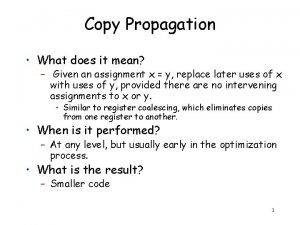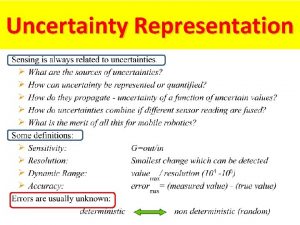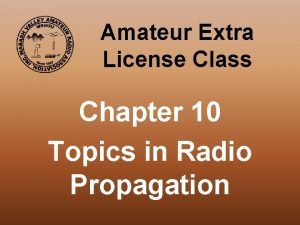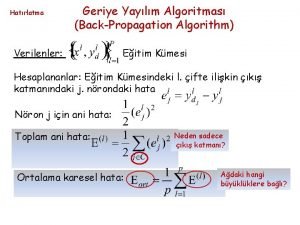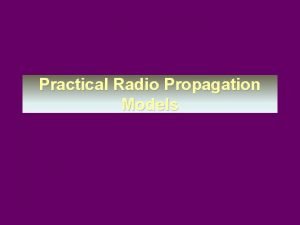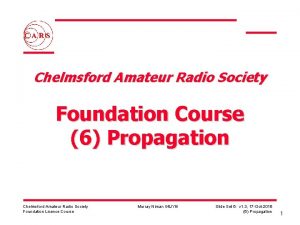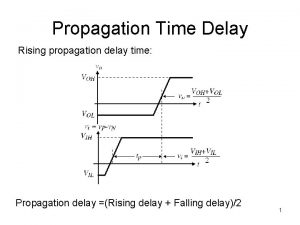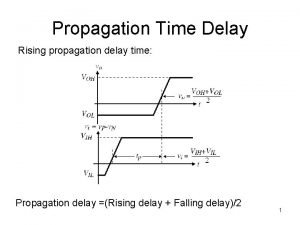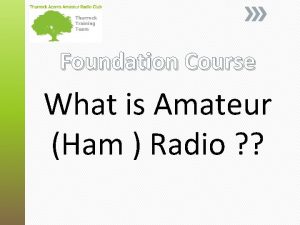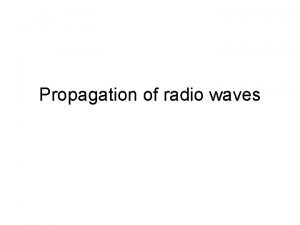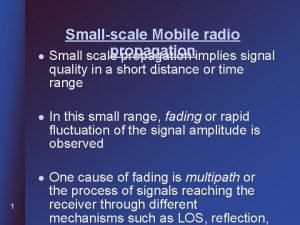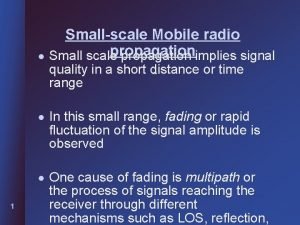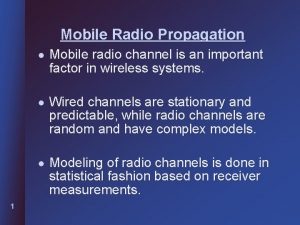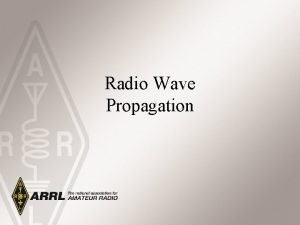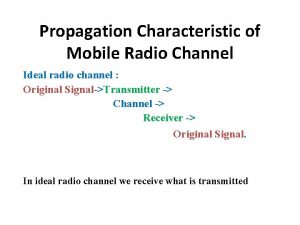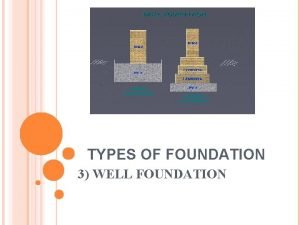Foundation Course Propagation What is Radio Propagation Radio
















- Slides: 16

Foundation Course Propagation

What is Radio Propagation? Radio propagation is the behaviour of radio waves when they are transmitted, or propagated from one point on the Earth to another, or into various parts of the atmosphere (Wikipedia®) • A good understanding of this topic will assist you in transmitting and receiving stronger signals.

Radio Propagation Basics Radio waves normally travel in straight lines, unless : - • Diffracted (Waves may spread out/around hills or obstacles after passing through narrow gaps or around corners). • Reflected (Waves (especially at UHF+ ) may bounce of buildings). • Refracted (waves at VHF+ can be bent by high/low pressure-often termed a ‘lift’ or ‘ducting’. HF is bent by the ionosphere). They may also be effected by Aurora, Meteor scatter and Rain/Aircraft scatter particular at VHF+.

Radio Propagation Basics (2) Rather like a torch beam, Radio waves get weaker as they spread out.

VHF/UHF Propagation • Radio waves behave in a similar manner to light. At VHF and UHF, hills cause "shadows" with only a weak signal reaching the far side of the hill, if at all! • Radio waves also are weaker after penetrating solid materials (e. g. walls), but glass windows are more transparent to radio waves. • The range achieved at VHF/UHF is dependent on antenna height, a clear path and transmitter power. Higher antennas are preferable to higher power, because they improve both transmit and receive performance. • Outdoor antennas perform much better than indoor antennas due to the surrounding walls reducing their effectiveness.

VHF/UHF Propagation • At VHF/UHF, range generally decreases as frequency increases • In general, VHF/UHF waves have a range not much beyond "line of sight“. The range of VHF/UHF may be slightly beyond this due to refraction (bending of the wave )at the horizon. • VHF and UHF are normally used for local communications, whereas HF is suitable for long distance communication. • VHF and UHF signals go straight through the ionosphere and are lost in space [unless communicating with a satellite or spacecraft].

HF and the Ionosphere The ionosphere is a layer of conductive gas at heights between 70 and 400 km. It is part of the Earth's atmosphere that reflects HF radio waves back to Earth, giving the advantage of a greater range but it has no real effect on VHF or UHF radio waves that pass through and are thus lost into space.

HF and the Ionosphere • When using HF almost all communication relies on the waves being reflected by the ionosphere. • Worldwide propagation is possible on HF dependent on how well the Ionosphere bends the waves back to earth. Multiple ‘hops’ or ‘bounces’ may take place. • How effectively the ionosphere bends the waves back to the earth varies with frequency, time of day and season. • HF has the longest range followed by VHF and then UHF.

Revision Questions

The Ionosphere is A) layers of reflective air at heights of 70 to 400 km. B) another name for the air we breath. C) a type of spherical transmitting antenna. D) a piece of amateur radio test equipment.

Answer A) Layers of reflective air at heights of 70 to 400 km

An amateur wishes to achieve a greater range on VHF or UHF. Which option is likely to be most successful? A) Increase the antenna height above surrounding roofs. B) Use a longer feeder to the antenna. C) Use UHF for greatest range. D) Move the antenna onto the ground in the garden.

Answer A) Increase the antenna height above surrounding roofs.

Which of the following has the longest range? A) UHF B) VHF C) HF D) Microwaves

Answer C) HF

Thurrock Training Team
 Composition of urine
Composition of urine Shallow pad foundation
Shallow pad foundation A foundation course in value education
A foundation course in value education Snomed
Snomed Etco e learning
Etco e learning Half brick wall in stretcher bond
Half brick wall in stretcher bond Course title and course number
Course title and course number Course interne course externe
Course interne course externe Trunked radio vs conventional radio
Trunked radio vs conventional radio What is copy propagation
What is copy propagation Constant propagation in compiler design
Constant propagation in compiler design How to find relative error
How to find relative error Uncertainty propagation
Uncertainty propagation Chordal hop propagation
Chordal hop propagation Free radical substitution propagation
Free radical substitution propagation Backpropagation
Backpropagation Action potential propagation
Action potential propagation









